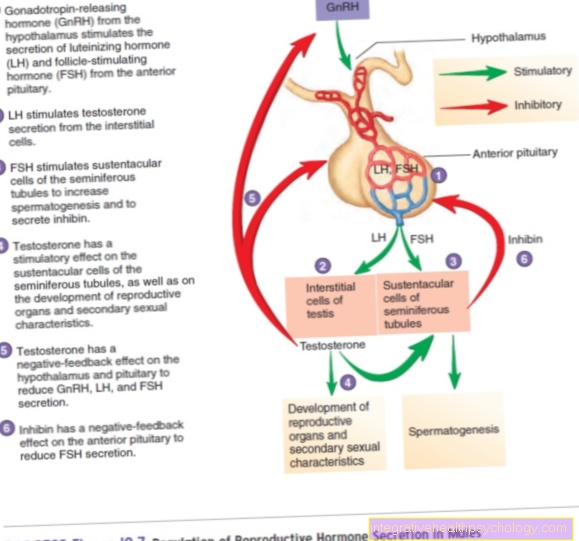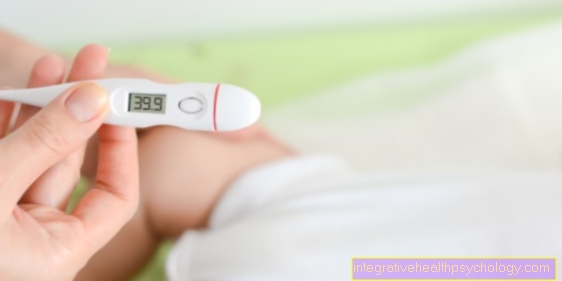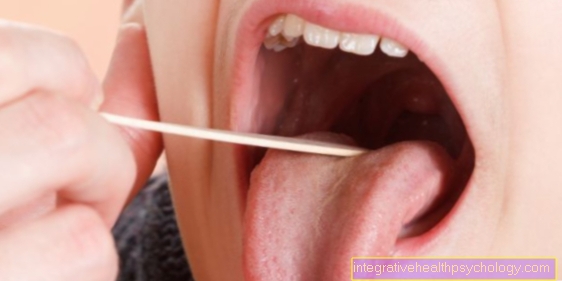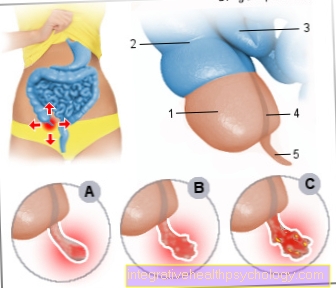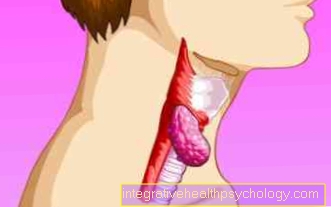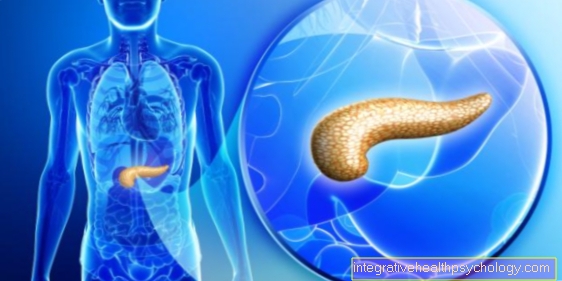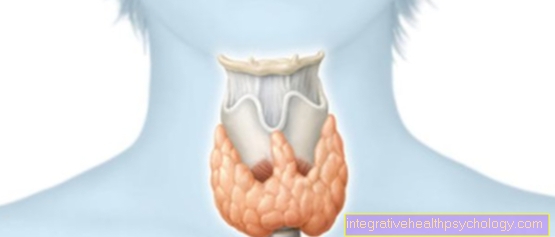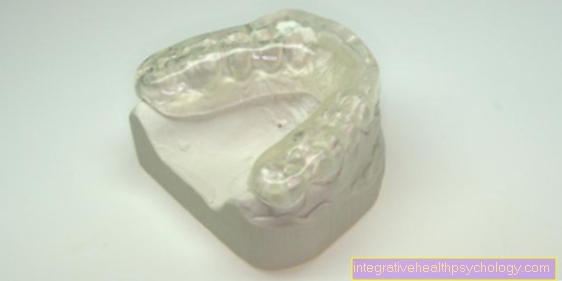Type 1 diabetes
Synonyms in the broader sense:
Diabetes mellitus, diabetes, juvenile diabetes, juvenile diabetes
English: diabetes type 1
introduction
The outdated term for the Type 1 diabetes reads "juvenile diabetes“And comes from the fact that mainly children and adolescents are diagnosed with this disease for the first time. This name type 1 diabetes is still widely used, but is considered obsolete as it is now known that adults can just as easily develop type 1 diabetes.
Type 1 diabetes is an autoimmune disease and is based on an absolute lack of insulin. This means that the hormone insulin, which is responsible for regulating the blood sugar level, is not produced at all or not produced in sufficient quantities by the body. This leads to the fact that those affected have a high blood sugar level. Since the sugar (glucose) is no longer absorbed by the blood into the cells, the next problem arises, namely the lack of sugar in the cells, where it is lacking as an energy supplier.
Epidemiology
In Germany there are currently around 7 million people living with diabetes mellitus. However, only about every 20th of them has type 1 diabetes mellitus, which corresponds to about 50,000 sufferers.
At 95%, type 1 diabetes is by far the most common metabolic disease in children and adolescents. In Germany, around 21,000 to 24,000 children are affected. The rate of new cases increases by about 3 to 5% every year.
Read more on the topic: Diabetes in Children
Causes of Type 1 Diabetes Mellitus
There are many causes of diabetes and several factors usually have to come together for a person to actually develop type 1 diabetes. There is both a genetic predisposition and various environmental factors that play crucial roles here.
One genetic factor found in almost all diabetics is a surface feature of the white blood cells. However, there are also healthy people who have the same characteristic on their cells. In the meantime, at least 20 genes have been identified that are linked to the development of type 1 diabetes mellitus. Environmental factors that have been proven to be associated with the development of this disease include various viruses (for example rubella, echo and herpes viruses), the early consumption of cow's milk or the protein gluten.
The result of the interaction of these factors is an autoimmune reaction of the body. This means that the immune system, i.e. the defense system, turns against the body's own structures, as it incorrectly identifies them as foreign and dangerous. In the case of type 1 diabetes, this defense reaction is directed against the B cells of the pancreas, which are responsible for the production of insulin. The death of the cells leads to an absolute insulin deficiency, whereby the disease only manifests itself when only 10 to 20% of the cells are still present.
Read more on the topic: Abandonment of insulin
Symptoms
The most common and characteristic symptom of type 1 diabetes is one rapid weight loss in shortest time. This is accompanied by a constant feeling of thirst, frequent and pronounced urination and the associated dehydration. This is because the body is no longer able to absorb all of the sugar from the urine above a certain glucose concentration in the blood, which means that more is excreted. In order to enable this elimination, increased amounts of water have to be added, which explains the urge to urinate and also the compensatory thirst. One should be particularly vigilant if these symptoms occur during or shortly after a Viral infection occur.
Except for blood sugar regulation, that is insulin also an important part of the body's fat balance and normally ensures that fatty acids are retained in the cells. In the event of a deficiency, there is therefore an increased accumulation of fatty acids in the blood, which, due to their large amount, cannot be sufficiently broken down and are therefore converted into so-called ketone bodies. Since both fatty acids and ketone bodies are acidic structures, the blood becomes acidic (ketoacidosis). Since the body's acid-base balance tolerates only very slight fluctuations, an excess of acid quickly leads to derailment of all metabolic pathways.
There are also general symptoms such as a headache, Difficulty concentratingVisual disturbances and fatigue, which are mainly due to the lack of sugar in the body's cells.
In the worst case, an affected person falls into a ketoacidotic coma, which is a life-threatening condition.
Symptoms or Complications of diabetesHowever, these only occur if the diabetes goes undetected or is poorly treated, among others high blood pressure, Heart attack, Vascular diseases (especially in the area of Retina, what the diabetic retinopathy and in the worst case to Blindness can lead), neuropathy and Renal failure.
diagnosis

There are several ways to diagnose diabetes, used in both type 1 and type 2 diabetes.
First of all, the blood sugar level should be measured, which should normally be below 110 mg / dl when fasting. If it is higher than 126 mg / dl, diabetes is present.
Various laboratory tests are also available. Above all, the measurement of the HbA1c. This is a value that affects hemoglobin, the red pigment in blood cells. Usually only a very small fraction of hemoglobin is associated with glucose. When there is an excess of sugar in the blood, as is the case with diabetes, this proportion is significantly increased above the normal 4-6% of hemoglobin. Since this value reflects the blood sugar level of the last few weeks, it is not only a good way to diagnose, but also to check whether a therapy for diabetes is successful. If it is in the normal range, consequential damage is unlikely.
In addition, there is the measurement of sugar or ketone bodies in the urine, which should be below a certain value in healthy people. In order to determine the body's own production of insulin, the so-called C-peptide can be measured in the blood. This is always released by the pancreas in the same amount as the insulin, which means that it is released.
Another way to detect diabetes early is to do the sugar stress test. Find out more at: Glucose Tolerance Test - What You Should Know!
A special feature of type 1 diabetes are also autoantibodies that are directed against the B cells of the pancreas. However, these are only detectable in about 80% of the cases.
A list of many autoantibodies and the clinical pictures they cause can be found at: Autoantibodies
therapy

In this type of diabetes, the insulin deficiency must be compensated for with the help of an artificially supplied insulin. There are various preparations that differ mainly in terms of their duration of effectiveness. On the one hand, there is normal insulin, which, however, shows a somewhat delayed onset of action, which is why it is taken at a certain distance with a meal and, on the other hand, there are insulin analogues in which the structure of the insulin has been modified to make it faster and / or longer effective to be.
Read about this: Test strips for blood sugar
This therapy has to be lifelong because it does not eliminate the cause of the insulin deficiency. It is therefore important to train patients to be able to inject insulin themselves. Diabetics also need to learn how food intake affects their blood sugar levels in order to be able to adjust the dose of insulin accordingly. As long as they pay attention to this, normal weight type 1 diabetics can eat completely normally. You can also read our topic Diabetes and Nutrition
Oral antidiabetic drugs such as those used in type 2 diabetes are of no use in this disease, as they serve to stimulate the release of insulin from the pancreas, which is not possible with type 1 because of the absolute insulin deficiency.
Prophylaxis:
Unfortunately, there are no preventive measures that can prevent the development of type 1 diabetes mellitus.
Summary
Type 1 diabetes is an autoimmune disease that often begins in childhood or adolescence and can be traced back to an absolute lack of insulin. As a result of the body's lack of blood sugar control, the blood sugar level in the blood and urine rises, which leads to poor performance, increased urination and a feeling of thirst.
With a well-controlled treatment with regular insulin or insulin analogues, patients can lead a barely restricted life, whereby it should be noted that they can never really get rid of the disease but can learn to deal with it.





